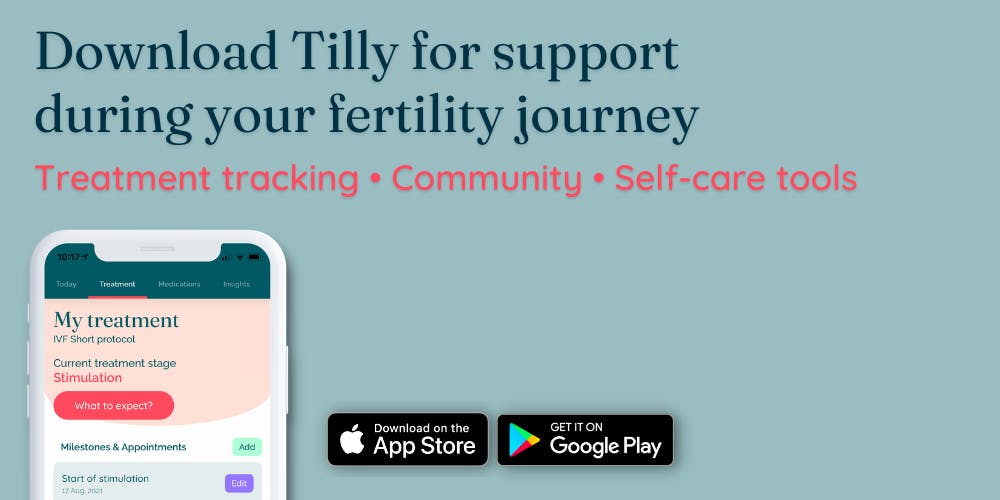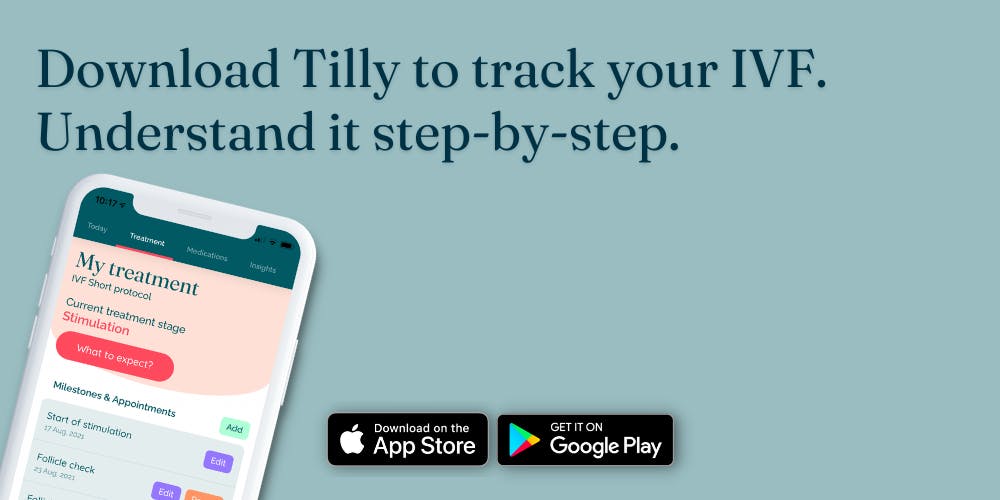What to expect during the different stages of IVF
IVF, also known as In Vitro Fertilisation, is considered one of the most common treatment for infertility, it is a process where an egg is combined with sperm ‘in vitro’, i.e. ‘in glass’ (or today more accurately in a ‘plastic Petri dish’) outside of the body.
In this article, we are going to have a closer lock at the IVF stages and what do you expect to see if you are undergoing IVF treatment.
1. Down-regulation
What happens during this phase?
- There are different protocols when doing IVF and in the so-called “long protocol” a period of down-regulation is needed before starting hormones that stimulate your ovaries to grow follicles (with the “short protocol” you start stimulation right away).
- The purpose of down-regulation is to block your hormone production to prevent your body from ovulating on its own (this could be compared to temporary menopause). In this way doctors can better control ovulation and egg maturation during your treatment.
- You will take hormones, normally in the form of nose spray and/or shots.
- When you start down-regulation depends on your cycle. If you have a regular cycle you normally start down-regulation around 7 days before your next period. If you have an irregular cycle or no cycle at all, you might need to take medications to force a menstruation before starting down-regulation.
- It normally takes around 2 weeks to down-regulate.
- If you have a regular cycle you should get your period after 2 weeks, which indicates that the down-regulation has been successful. Regardless if your period has come by then or not you should be in contact with your clinic after 2 weeks to set a plan for the next step; starting stimulation (if you started bleeding) or come in for an ultrasound and estradiol test (if you didn't).
- If you have an irregular period, you will need to visit your clinic to do ultrasounds and take blood tests to measure your estradiol levels to decide when you’re down-regulated.
Potential side effects and symptoms of down-regulation
- Going through down-regulation can be compared to temporarily going through menopause. This means you might get symptoms related to menopause, both physical and emotional, including headaches, migraines, hot flushes, feeling irritable, down, or even depressed. This might be tough, but not dangerous (hang in there trooper!).
- If your symptoms are affecting the quality of your daily life, don’t hesitate to contact your clinic for counseling.
To be aware of…
- Sometimes down-regulation takes longer than planned. This does not mean the treatment has failed, it’s just a bump in the road and your clinic should help you set a plan. Make sure you get all the answers you need to feel safe and secure.
Don't forget...
- Taking your shots at the right time is very important. You can use Tilly's app to keep track of medications.
- If your treatment protocol is updated, don’t forget to update this in the app.
If you feel worried about taking the shots
- Taking the shots is something many women worry about when going through IVF. Tell the clinic that you are worried and that you want careful instructions on how to take the shots. Don’t hesitate to ask questions and make them show you several times how to do it.
- A tip is to film the nurse during the demonstration so you can look at it again at home.
- If possible and if that feels more comfortable to you, maybe you can ask your partner or a friend to help you out with the shots.
2. Stimulation
What happens during this phase?
- In this phase, you will inject hormones daily to help your ovaries grow a large number of follicles - follicles that contain your egg cells. You take the shots at the same time everyday, normally in the evening.
- In a natural cycle only one follicle (sometimes two) releases an egg at ovulation, but in IVF you want to generate as many mature eggs as possible to increase the chances of success.
- During the stimulation phase you do regular ultrasounds to see how your ovaries react to the treatment. Your doctor checks the number of follicles and their size.
- Following how your ovaries react to stimulation will help your doctor to decide if your medication protocol is working or if it has to be changed, and also the optimal time for egg retrieval.
- The stimulation phase usually lasts about 9-11 days.
- You start with hormones that help your follicles grow, usually FSH or hMG. After 5-6 days you add another medicine, called an antagonist, that prevents your ovaries from releasing your eggs. If your body ovulates too early the treatment will fail since the doctors are not able to retrieve the eggs.
- Finally, you will receive a shot with the hormone HCG to trigger eggs to go through the final stage of maturation. The timing of this shot is vital, it needs to be taken 36-38 hours before egg retrieval.
Alternatives and decisions during this phase
- Your stimulation protocol.
- Your doctor will decide on a protocol (medication types, doses and duration) based on your AMH-value and ultrasounds - how many follicles you have is used to predict how you will react to stimulation. You can read more about choosing the right protocol here.
- Protocol adjustments during treatment
- How you will react to stimulation medicines can be hard to predict, and sometimes some adjustments need to be done. This is both common and normal. Your doctor will take decisions after each ultrasound based on how few or many follicles are maturing.
- When to take the ovulation trigger
- When you have 3 or more follicles around a size of 18-20mm it’s time to take the ovulation trigger shot and plan for egg retrieval (which takes place 36-38 hours later). It’s important to take this shot at the exact time your doctor gives you.
Potential side effects and symptoms
- When taking hormones you might experience some side effects like headaches, tiredness, feeling irritable or down, nausea, bloating or tender breasts. How you will react is individual, some get a lot of side effects and some get few or none at all.
- Side effects can be very unpleasant, but it’s normally nothing to worry about - as a woman you’re aware that hormones can affect how you feel and that’s basically what’s happening now (although we’d rather not have to take tons of hormones of course).
- It’s also common to get some bruising from the injections.
- Another potential side effect is Ovarian Hyperstimulation Syndrome (OHSS), often just called overstimulation. This is when your ovaries respond “too well” to the hormones. The risk is higher for women with many follicles, for example if you have PCOS.
- You should always tell your clinic if you experience OHSS-symptoms like nausea, bloating, stomach pain or breathing difficulties during stimulation so that they can make adjustments. OHSS can become serious since the ovaries can get dangerously filled with fluid that can leak into your belly and chest area - this is uncommon, but it’s important to identify OHSS early on so it doesn’t go that far.
To be aware of...
- If not enough follicles grow, the cycle may be cancelled. Most clinics don’t go through with an egg retrieval if there are less than 3 follicles. This can of course feel devastating, having invested so much time and energy already. It’s important to remember it doesn’t necessarily mean it won't work the next time though. Sometimes it takes a few attempts to find the perfect stimulation protocol that will work for you. Make sure your doctor is giving you all the answers you need to feel safe and secure before giving it another try.
- A low egg reserve is the primary thing that can make it harder to succeed with this step of the treatment.
Don’t forget...
- Taking your shots at the right time is very important, which Tilly's app can help you with.
- If your treatment protocol is updated, don’t forget to update this in the app.
- During stimulation you should avoid sexual intercourse a week before retrieval of the eggs and the days following the retrieval. This is due to the risk of infection, but also because sometimes eggs that have not been retrieved can find their way out and be fertilised which can lead to multiple pregnancy.
If you feel worried about taking the shots
- Taking the shots is something many women worry about when going through IVF. Tell the clinic that you are worried and that you want careful instructions on how to take the shots. Don’t hesitate to ask questions and make them show you several times how to do it.
- A tip is to film the nurse during the demonstration so you can look at it again at home.
- If possible and if that feels more comfortable to you, maybe you can ask your partner or a friend to help you out with the shots.
3. Egg retrieval & Sperm sample, Fertilisation & Growing embryos, and the rest of the steps...
Add your treatment in Tilly's app to receive timely inforamtion about each step of the journey - download here.

2023-01-13

Evangelia Elenis, MD, PhD.
This text is fact checked by Evangelia Elenis, MD, PhD. Dr. Elenis is a chief physician in Obstetrics and Gynecology, and a subspecialist in Reproductive Medicine. She is a PhD and affiliated researcher at Uppsala University with postdoctoral studies at Harvard Medical School.
A mental health app for your fertility journey
Evidence-based self-care tools and facts. Supportive community. Treatment tracking.
Previous articles
Breaking the silence: Infertility and stress during stress awareness month
2025-04-14
Exciting news: Tilly is now part of Rhea
2025-03-31
How infertility impacts men's mental health and ways to cope
2024-11-22
Baby Loss Awareness Week: coming together to support those affected
2024-10-14
PCOS and mental health: a crucial connection
2024-09-25
How to support a friend struggling with involuntary childlessness: A guide for loved ones
2024-09-17
